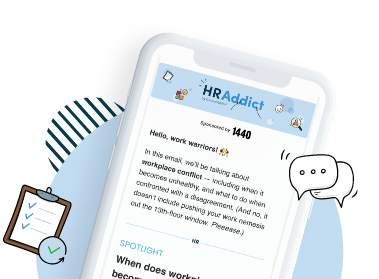One of my first experiences in an office was similar to The Devil Wears Prada. A bad manager barking orders at me, shouting for no reason, and expecting overtime on an increasingly low wage. As a fresh-out-of-university graduate, it’s a time where I needed guidance, training and support, but unsurprisingly, that wasn’t offered. So, what did I do? Quit for a better working environment!
If you’re a manager, you may be unaware of the poor working conditions that you’re creating with a lack of employee recognition and engagement. So, to help you get up to speed, we’ve listed the effects of poor management.
1. High employee turnover
The most obvious effect of bad management is high employee turnover. During a survey that we conducted on why people quit their jobs, a whopping 79% of respondents said that they quit due to bad leadership. So, if you noticed that employees are often fleeing and you’re spending a lot of your time trying to fill roles, your management style could be the issue!
2. Low employee morale
When nothing seems to satisfy the manager, employees will naturally feel deflated and have a low morale. It’s hard to maintain a high level of enthusiasm when you’re constantly receiving criticism and negative remarks. Many managers don’t understand that employees need praise for their work and recognition for their achievements to boost their confidence and enjoyment at work. Even if you love what you do, after doing the same thing for a while, you’re going to feel a bit deflated and need a boost of positivity to keep you motivated.
3. Waste of resources
With employees leaving and an ongoing hiring process, you’re going to waste important resources. Besides the cost of recruiting, you’re also wasting time conducting exit interviews for employees that have quit, interviews for new hires and time training new members of staff. It’s much better to use that budget for team events, training days and anything else that will be beneficial to the team and boost employee engagement.
4. Demotivated employees
From past experiences, I’ve felt extremely demotivated when I’ve had a bad manager. I lacked the enthusiasm to do more, offer new suggestions and turn up to work with a positive attitude. When your hard work isn’t noticed or rewarded, you start to feel a lack of engagement and retract. So, if you’ve noticed that all your team members seem disengaged, this is a good time to look at your management style.
5. Risk of legal issues
Depending on the nature of your workplace, performance reviews and behavior, an employee may decide to take legal action if they feel like they haven’t been treated or evaluated fairly. Therefore, bad management can go far beyond an unhappy employee, but can actually become a significant problem that costs your company and yourself a lot of money!
6. Poor employee health
A toxic work environment can negatively affect an employee’s physical and mental health — so much so that it can even shorten their life. Research carried out by Jeffrey Pfeffer, professor of organizational behavior at Stanford Graduate School of Business, found that negative workplaces have a detrimental impact on employee health.
Similarly, my bad experience with a toxic manager left a long-standing effect on my mental health. I went from a confident and self-assured professional to someone who questioned their every move and lacked confidence in the workplace. It took a lot of pep-talks and a good work environment to make me realize my worth and value once more.
7. Decreased productivity
Effective leadership makes the workplace great. It drives results and makes everyone feel appreciated. On the other hand, bad leadership drives staff into the ground. If an employee is constantly scrutinized or even bullied, they are going to feel unproductive and unenthusiastic about their work. So, if you’ve noticed a shift in productivity, it’s a good idea to review your management to ensure you’re creating a good environment following HR policies.
8. Damaged company reputation
With company reviews being readily available on websites such as Glassdoor, it’s easy to unravel the inside workings of a company. And in today’s fast-paced job economy, employees applying and interviewing for a position will check out the company’s reputation and profile before making their decision. So, if you have a negative rep, it’s going to have lasting consequences when it comes to finding and retaining good talent.
9. Decreased profits
Similar to a damaged reputation, poor management will also drive profits down. With employees not working to their full potential, they won’t be enthused enough to bag deals, make sales and increase profits for the company. They will simply do the bare minimum to get their paycheck and get out of there as fast as they can.
10. Business failure
Over time, the results of bad management can be detrimental to the company’s success and even lead to business failure. The cost of recruitment, as well as competitive salaries and other outgoings associated with new staff, can burn all the company’s resources while there is a lack of profits, forcing the company to claim bankruptcy and close. A few examples of companies that have been in this situation are Woolworths, Kmart and Toys R Us.
11. Poor communication
Bad communication will make an employee feel disconnected from their manager and affect their trust, creative a negative environment, which will ultimately impact the employee’s performance and affect their productivity. In order to be successful, you need good communication tools ensuring that all staff members share the same goal.
12. High sickness rate
As we discussed earlier, bad management can have a negative effect on physical and mental health. This, in turn, causes increased sickness rates. Employees will dread going into work and will often take sick days as they just can muster the energy or feel physically sick from the negative working environment.
13. Poor hiring decisions
If you lack key management skills, you’re most likely going to make poor hiring decisions. You won’t have the ability to identify key skills or personality traits that an employee will need to thrive in the working environment. Instead, you may focus solely on your personal opinion from the interview, rather than reviewing the candidates’ skills and experience also.
How to cut the bad management cord
Now that you know the effects of bad management, the first step to rectifying it is to admit that there is an issue. The next step is simple: review all managerial positions to ensure that the people in these roles are a good fit and have had the proper training to lead teams, encourage employees and drive results.
As well as doing a higher-level overview, it’s important to review HR policies and company culture. If there is a lack of both, it’s time to set up an effective HR department that is focused on employee satisfaction and fairness.
Consider creating employee wellness programmes, rewards and perks, like in-office treats, bonus schemes or anything else that is relevant to your business and employees. If you’re unsure what would be appreciated, why not get your employees involved in the change by conducting a survey? Not only will they feel heard, but employees who are considering quitting may change their mind once they’ve seen a shift in your structure, which will help you retain good staff.
In addition, it’s important to stay organized and keep your employees updated on any staffing or company changes. Consider shared calenders, monthly meetings and minutes, as well as weekly roundups to share key information.
The key point when shifting from a bad working environment to a good one is to build trust with your employees. When they feel trusted, they are more likely to stay loyal to the company and reject any offers that come their way. As a manager, you want to receive positive feedback on the company’s environment.
Final thoughts
If you notice a similar pattern in your workplace, it’s time to make some positive changes to ensure that you’re retaining staff and decreasing turnover. As well as pay, jobseekers are now seeking for a good company culture with plenty of perks and employee benefits.
So, if your company is lacking in this area, consult HR experts or check out our other HR related articles to find out how to build a thriving work environment:
Are you experiencing a disengaged workforce? Do you think that you could be guilty of a few of these points? Let us know your thoughts and experiences by leaving a comment in the section below.
This is an updated version of an article originally published back in 2017.

